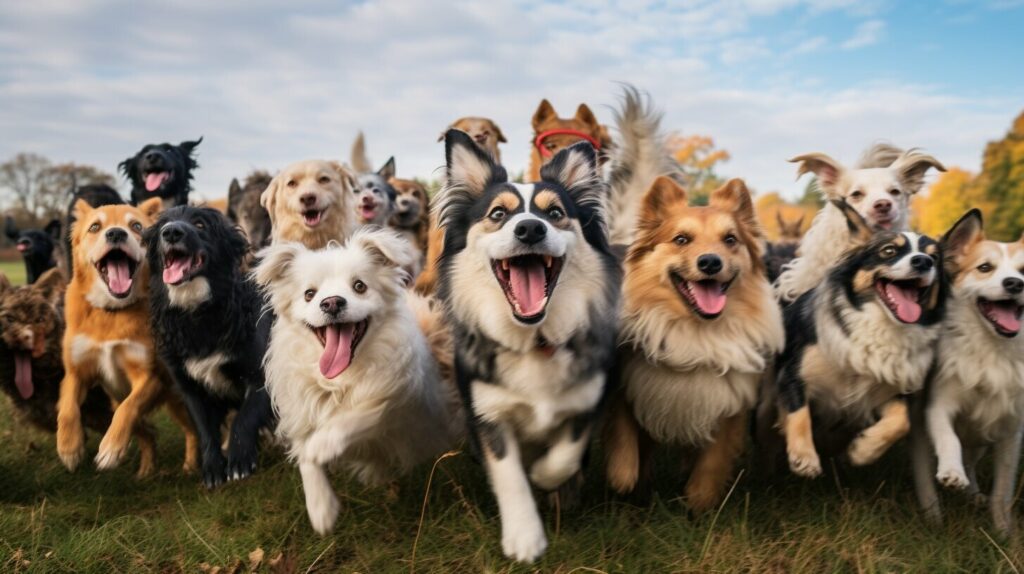Have you ever encountered a dog that made you feel scared or uneasy? It’s not uncommon to experience fear of dogs, especially if you’ve had a negative experience in the past. However, some breeds of dogs are often perceived as scary due to their appearance or reputation.
In this section, we will explore the reasons behind why certain dogs can be perceived as scary. We will delve into factors such as breed characteristics, past experiences, and individual differences that contribute to this perception. By understanding the root of our fear, we can better cope with scary dogs and promote positive interactions.
Key Takeaways:
- Dogs can be perceived as scary due to factors such as breed characteristics, past experiences, and individual differences.
- Fear of dogs is not uncommon, and can be managed through education and understanding.
- By learning how to cope with scary dogs, we can promote a positive relationship between humans and dogs.
Understanding Scary Dog Behaviors
Dogs are naturally curious creatures, and sometimes that curiosity can be misinterpreted as aggression. If you have a fear of dogs, it’s essential to understand the most common behaviors that can make dogs appear scary. Recognizing these behaviors allows you to interpret a dog’s body language and avoid unnecessary conflicts.
Barking, growling, and lunging are some of the most concerning behaviors that can make dogs appear aggressive. However, it’s essential to understand the underlying reasons for these behaviors. A dog may bark because they are alerting their owner of a perceived threat, or they may be fearful and trying to scare away a perceived threat. Growling can occur when a dog is warning you to stay away or when they are playing. Lunging can be a sign of aggression, but it could also indicate excitement or a desire to play.
Understanding Scary Dog Behaviors
It’s important to pay attention to a dog’s body language and interpret their behavior correctly. For example, a wagging tail doesn’t always indicate a happy dog. A relaxed and raised tail is a sign of calmness, while a low and stiff tail indicates fear or anxiety. Similarly, a dog’s ears can tell a lot about their mood. Perked ears and alertness indicate they are paying attention, while tucked-back ears indicate fear or submission.
Coping with scary dogs requires understanding these behaviors and how to react appropriately. If a dog appears agitated, it’s best to give them space and avoid direct eye contact, as this can be perceived as a threat. If a dog comes towards you, try to remain still and calm, letting them sniff you before attempting to pet them.
In summary, recognizing and interpreting a dog’s behavior is crucial in overcoming a fear of dogs and coping with scary dogs. Understanding the reasons behind barking, growling, and lunging, and interpreting body language allows for safe and respectful interactions between humans and dogs.
The Influence of Breed Characteristics
Some breeds of dogs are often considered scary due to their physical appearance, size, or historical reputation. However, it’s important to understand that breed characteristics alone do not determine a dog’s behavior and personality. It’s crucial to approach each dog as an individual and not generalize based on their breed.
That being said, some breeds are more likely to display certain behaviors or traits. For example, the Pit Bull breed has often been associated with aggression, but this is largely due to their past use in dogfighting. With proper socialization and training, Pit Bulls can make loving and loyal companions.
Other breeds, such as the Rottweiler and Doberman Pinscher, have also been labeled as scary due to their size and strength. However, these breeds are often gentle and affectionate with their owners and well-behaved around strangers with proper training.
If you encounter a scary breed of dog, it’s important to evaluate the situation and approach cautiously. Don’t make sudden movements or loud noises that could startle the dog. If the dog is loose and unaccompanied by an owner, it’s best to contact animal control or a local rescue organization for assistance.
Remember, every dog is different, and breed characteristics should be taken into account when assessing a dog’s behavior, but they should not be the sole factor in determining whether a dog is scary or not. Approach each dog with respect and caution, and take the time to get to know them as an individual.
Overcoming the Fear of Dogs
Having a fear of dogs can be distressing and limiting. It can prevent you from enjoying outdoor activities, visiting friends or relatives with dogs, or even walking down the street.
If you suffer from a fear of dogs, it’s important to remember that you are not alone. Many people share this fear, and it’s entirely possible to overcome it.
How to Overcome Fear of Dogs
Here are some strategies to help overcome your fear of dogs:
- Education: Learning more about dogs, their behavior, and body language can help dispel myths and improve your understanding.
- Desensitization: Gradually exposing yourself to dogs in a controlled and safe environment can help reduce anxiety and fear.
- Positive reinforcement: Experiencing positive interactions with dogs, such as playing with a friendly dog or seeing a well-trained dog, can help build confidence.
- Professional help: Seeking the help of a qualified dog trainer, behaviorist, or therapist can offer valuable guidance and support.
By taking steps to overcome your fear of dogs, you can gain a sense of control and freedom. It’s important to go at your own pace and seek support when needed.
Coping with Scary Dogs
When encountering a scary dog, it’s important to stay calm and avoid making sudden movements. Here are some tips:
- Don’t approach the dog
- Stand still, with your arms by your side and your hands in fists
- Avoid making direct eye contact with the dog
- Use a calm voice to speak to the dog
- Let the dog approach you, instead of vice versa, if it chooses to do so
- Back away slowly if the dog becomes more aggressive
Remember that most dogs are not scary, and it’s important not to generalize based on one or a few experiences. By following these tips and seeking support if needed, you can safely navigate encounters with scary dogs.
The Power of Desensitization
If you have a fear or phobia of dogs, desensitization can be a powerful tool to gradually reduce your anxiety and fear. The process involves exposing yourself to dogs in a controlled and gradual manner, allowing you to become more comfortable with their presence over time.
Here are some steps to help you begin the desensitization process:
- Start small: Begin by exposing yourself to pictures of dogs or videos of dogs from a distance. As you become more comfortable, move on to videos or pictures of dogs at a closer distance.
- Exposure: Once you are comfortable with pictures and videos, you can move on to observing dogs from a distance, such as at a dog park. Gradually decrease the distance until you feel more comfortable being closer to dogs.
- Interaction: The final step is to interact with dogs in a controlled setting. This can be done with the help of a professional dog trainer or behaviorist who can guide you through the process and ensure your safety.
Remember that desensitization can take time, and it’s important to be patient and not rush the process. Seek professional help if needed and don’t hesitate to take breaks when necessary. With persistence and patience, you can overcome your fear of dogs and learn to cope with scary dogs in a more positive way.
Tales of Scary Dogs: Separating Fact from Fiction
Scary dog stories have been around for ages, and media portrayals of vicious dogs have only fueled our fear and anxiety towards certain breeds. However, it is important to differentiate between fact and fiction when it comes to scary dog stories.
While it is true that there have been instances of dog attacks, it is crucial to understand that these incidents are not representative of the majority of dogs. Most dogs are friendly and pose no threat to humans. It is also essential to recognize that a dog’s behavior is largely influenced by their owners’ training and socialization efforts.
Instead of relying on scary dog stories and media portrayals, it is crucial to educate ourselves on dog behavior and body language. By understanding a dog’s warning signs, we can avoid situations that might trigger fear or aggression.
Remember, owning a dog is a significant responsibility that requires proper training and socialization. By providing your dog with adequate exercise and mental stimulation, you can promote positive behavior and reduce the risk of aggression.
It is also important to recognize that dogs, like humans, may experience fear and anxiety. Punishing or isolating a scared dog can exacerbate their negative behavior and lead to aggression. Instead, it is crucial to approach scared dogs calmly and respectfully, respecting their boundaries and offering positive reinforcement.
In summary, separating fact from fiction when it comes to scary dog stories is essential in promoting understanding and reducing fear. By educating ourselves on dog behavior and promoting responsible ownership, we can enhance our relationships with dogs and build a more positive and safe community for both humans and animals.
From Big Screens to Reality: Scary Dog Movies
Scary dog movies are a popular genre, but they can have a profound effect on our perception of dogs. It’s important to remember that these movies are fictional and do not necessarily reflect reality. Unfortunately, many people have developed a fear of dogs due to the influence of movies like Cujo and The Omen.
It’s important to differentiate between entertainment and real-life scenarios. The dogs in these movies are often portrayed as aggressive and dangerous, but this is not always the case in real life. While certain breeds have a higher likelihood of displaying aggression, it’s important to remember that individual temperament and training also play a significant role.
If you are coping with a fear of dogs, it’s important to avoid scary dog movies and other media that might trigger anxiety. Focus on positive interactions and education to build confidence and reduce fear.
Safely Navigating Encounters with Scary Dogs
Encountering a scary dog can be a daunting experience, but there are practical steps you can take to ensure a safe interaction for both you and the dog. Here are some tips:
Assess the Situation
Before approaching a dog, assess the situation to determine the level of risk. If the dog is off-leash and showing aggressive behavior, it’s best to stay away and contact animal control or the owner if possible. If the dog is leashed and appears calm, ask the owner if it’s okay to approach and pet the dog.
Respect the Dog’s Body Language
Dogs communicate their feelings through body language. When encountering a scary dog, pay attention to their body language and respect their boundaries. If the dog is growling or barking, it’s a sign they are uncomfortable and want to be left alone.
Use Positive Reinforcement
If the dog allows you to approach, use positive reinforcement by offering treats or toys. This can help build trust and create a positive association with humans.
Avoid Eye Contact and Sudden Movements
Eye contact and sudden movements can be perceived as threatening to dogs, especially when they are scared or anxious. Avoid direct eye contact and sudden movements to prevent the dog from feeling threatened.
Back Away Slowly
If the dog starts to show signs of aggression, back away slowly without turning your back on the dog. This can help prevent the dog from feeling threatened and prevent any potential attacks.
Remember, it’s important to promote responsible pet ownership and create positive interactions with dogs to reduce fear and promote understanding. By following these tips, you can safely navigate encounters with scary dogs and promote a positive relationship between dogs and humans.
Seeking Professional Help
If you are struggling with coping with scary dogs, seeking professional help might be necessary. Professional dog trainers, behaviorists, or therapists can provide guidance and support in helping you overcome your fear and develop positive interactions with dogs.
When selecting a professional, make sure to do your research and choose someone with the appropriate credentials and experience to address your specific needs. Look for reviews or recommendations from others who have sought their services.
Professional intervention can be especially important if you have had a negative experience with a dog in the past, or if your fear is impacting your daily life. They can provide a personalized plan to help you gradually become more comfortable around dogs, and teach you skills to safely navigate encounters with scary dogs.
Remember, seeking professional help is never a sign of weakness. It takes courage to confront your fears and seek assistance, and it can lead to significant improvements in your quality of life.
Promoting Positive Dog-Human Relationships
One of the most effective ways to cope with scary dogs is by promoting positive interactions between dogs and humans. By fostering a better understanding of dogs and their behavior, we can reduce fear and create a safe environment for both dogs and humans.
Early socialization is crucial in shaping a dog’s behavior towards humans. Introducing puppies to various environments, people, and other dogs can help them develop positive associations and reduce the likelihood of fearful or aggressive behavior later on.
Responsible dog ownership is another essential factor in promoting positive dog-human relationships. This includes proper training, exercise, and healthcare, as well as following leash laws and respecting other people’s boundaries. By being a responsible dog owner, you can help prevent negative interactions and set a positive example for others.
Community education programs can also play a vital role in promoting positive dog-human relationships. These programs can help people understand dog behavior, learn how to safely interact with dogs, and encourage responsible pet ownership. Such programs can be found at local animal shelters and dog training facilities.
Ultimately, promoting positive dog-human relationships comes down to empathy, mutual respect, and responsible behavior from both humans and dogs.
Conclusion
Understanding why some dogs can be perceived as scary requires a willingness to explore various factors that contribute to this perception. By delving into breed characteristics, behavior, and individual experiences, you can build a deeper understanding of why some dogs might be daunting.
Overcoming fear is an essential part of promoting positive relationships with dogs. Strategies such as desensitization and seeking professional help can help you build confidence and manage any anxiety you might feel when encountering scary dogs.
Lastly, promoting responsible dog-human interactions is critical to ensuring the safety of both dogs and humans. By embracing early socialization, responsible ownership, and community education programs, you can help foster a culture of understanding and respect between dogs and humans.
FAQ
Q: Why are some dogs perceived as scary?
A: Dogs can be perceived as scary for a variety of reasons, including breed characteristics, past experiences, and individual differences in perception.
Q: What are some common behaviors that make dogs appear scary?
A: Common behaviors that can make dogs appear scary include barking, growling, and lunging. However, it’s important to understand the underlying reasons for these behaviors and interpret them correctly.
Q: Are there specific dog breeds that are often considered scary?
A: Yes, certain dog breeds are often considered scary due to their physical appearance, size, or historical reputation. However, it’s important to understand that breed characteristics alone do not determine a dog’s behavior.
Q: How can I overcome my fear of dogs?
A: Overcoming a fear of dogs can be achieved through various strategies and techniques, including gradual exposure, education, and seeking professional help if needed.
Q: What is desensitization and how can it help with fear of dogs?
A: Desensitization is a technique that involves gradually exposing oneself to a feared object or situation in a controlled manner. It can be applied to reduce fear and anxiety towards dogs by incrementally increasing exposure and building confidence.
Q: How do scary dog stories and media portrayals impact our perception of dogs?
A: Scary dog stories and media portrayals can influence our perception of dogs by shaping our beliefs and fears. It’s important to separate fact from fiction and seek a balanced understanding of dog behavior.
Q: Are there any practical tips for safely interacting with scary dogs?
A: Yes, when interacting with scary dogs, it’s important to respect their boundaries, avoid sudden movements, and give them space. Additionally, promoting responsible pet ownership and education can help create safer environments for both dogs and humans.
Q: When should I seek professional help when dealing with scary dogs?
A: It may be necessary to seek professional help, such as dog trainers, behaviorists, or therapists, when dealing with scary dogs. Professionals can provide guidance, training, and support to ensure the well-being of both the dog and the individuals involved.
Q: How can we promote positive dog-human relationships and reduce fear?
A: Promoting positive interactions between dogs and humans can be achieved through early socialization, responsible dog ownership, and community education programs. By understanding and respecting dogs, we can build positive relationships and reduce fear.



